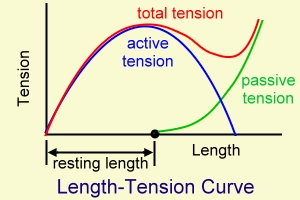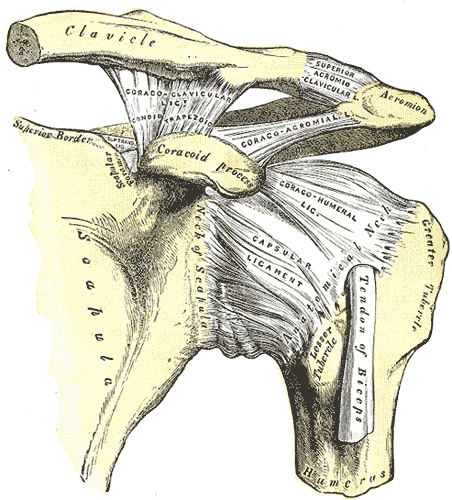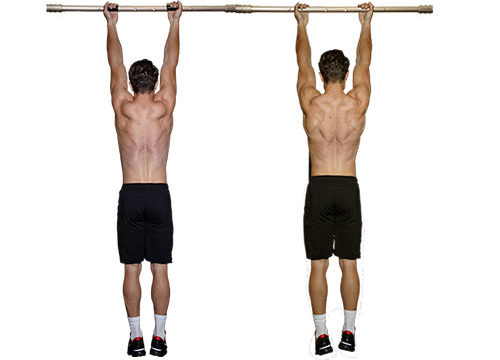OK, this kind of came up in the bodyweight thread in weight room, but let’s analyze the “conundrum” of relaxing your shoulders at the end range of pullups.
There’s generally two key points that I want to make.
- Hanging at the bottom of pullups where the GH joint (shoulder) is approximately in end range flexion can aggravate some people’s shoulders, especially those with previous injury history such as chronic instability, subuxations and dislocations, and/or poor mobility to go overhead. Basically, you can tell if this is you if your shoulders are uncomfortable/painful at the bottom or feel like they’re going to pop out of the joint. It can vary depending on injury condition such as tendonitis, impingement, bursitis, or others. Thus, it is not for everyone. If you’ve had previous injuries in your shoulders and relaxing at the bottom is bothersome I would suggest not doing it.
- However, it is a useful range of motion if your shoulders are not hurt and/or you have rehabilitated your shoulders to hang from this position. You do get a bit of extra range of motion and scapular muscle activation (due to having to retense the scapular muscles and bring them into a more optimal position), but there’s no inherent thing about extra connective tissue strengthening. It doesn’t really strengthen the connective tissue anymore than other movement.
Static hang — at the bottom of a pullup or other movements
What happens when you relax at the bottom of a pullup is that the muscles are going to stretch until they get to a certain length where the muscle spindles kick in with involuntary muscle activity to avoid the joint from subluxing or dislocating. The scapular muscles will also limit this in terms of the scapulas elevating too far up the rib cage. It’s neither bad or good to allow this. It’s just some extra range of motion.
The muscle spindles involuntary kick in for other movements where the humerus is being pulled away from the GH joint such as deadlifts. So there’s nothing really inherently bad about that; it’s just the body’s way of preventing a possible injury condition just like the muscles getting tight when you stretch them towards any other end range of motion.
This is illustrated below:

Illustration from ???
In general, there is a spectrum of loading the muscles to end range.
The active tension is the ability of the muscles to apply forces at end range. As the muscle is further lengthened, the body will increase the tension in the muscle to prevent it from getting longer as above. As the passive tension increases toward absolute end range, the loading of the ligaments starts to increase to prevent subluxation/dislocation of the joint.
There’s some slight benefits in getting the scapular muscles through a bit more range of motion, but often times this is out weighed by previous injury history or other aggravation to the shoulders at end range. If you can do it and want to do it go for it. If you can’t do it and want to do it, then it can be built up to as long as you rehab properly. If you don’t want to do it then I wouldn’t really worry about it too much.
The connective tissue structures of the ligaments are not loaded significantly unless excessive or external forces are applied. Let’s talk about that now.
Dynamic forces at the bottom of a hang

Photo from wikipedia.org
Overall, if the shoulder gets yanked in the socket to where extra force is applied at end range, passive structures will start to take on a large part of the load. For example, the glenohumeral ligaments and capsular ligaments will kick in along with the long head of the biceps to prevent the shoulder from moving too far out of the labrum socket.
This is the case where dynamic force at the bottom of a movement can be dangerous to the shoulders. This has been the occasional case in CrossFit with those newer to learning kipping pullups: the dynamic movement on the shoulder coupled with lack of strength and fatigue can lead to a SLAP lesion. A SLAP lesion is where the long head of the biceps pulls away from its connection the superior part of the labrum. This is the SLAP lesion — Superior Labrum Anterior to Posterior tear.
Overall, dynamic movements can be trained safely for the shoulders. For example, gymnasts progressively work high bar and rings swings to where their shoulders are ready for the forces at the bottom of the movements. Giants — swinging around the high bar and rings in a full circle — put upwards of 6+ times bodyweight force on the shoulders. However, these are progressed with higher and higher swings as opposed to just jumping straight into them.
Overall, if you are going to work dynamic swinging movements, ensure that you use correct technique and progressions to prevent injury.
Originally posted on reddit, updated with more information. Intro chinup/pullup hang photo from http://bretcontreras.com
Author: Steven Low
Steven Low is the author of Overcoming Gravity: A Systematic Approach to Gymnastics and Bodyweight Strength (Second Edition), Overcoming Poor Posture, Overcoming Tendonitis, and Overcoming Gravity Advanced Programming. He is a former gymnast who has performed with and coached the exhibitional gymnastics troupe, Gymkana. Steven has a Bachelor of Science in Biochemistry from the University of Maryland College Park, and his Doctorate of Physical Therapy from the University of Maryland Baltimore. Steven is a Senior trainer for Dragon Door’s Progressive Calisthenics Certification (PCC). He has also spent thousands of hours independently researching the scientific foundations of health, fitness and nutrition and is able to provide many insights into practical care for injuries. His training is varied and intense with a focus on gymnastics, parkour, rock climbing, and sprinting. Digital copies of the books are available in the store.
